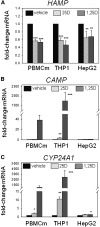Suppression of iron-regulatory hepcidin by vitamin D
- PMID: 24204002
- PMCID: PMC3935584
- DOI: 10.1681/ASN.2013040355
Suppression of iron-regulatory hepcidin by vitamin D
Abstract
The antibacterial protein hepcidin regulates the absorption, tissue distribution, and extracellular concentration of iron by suppressing ferroportin-mediated export of cellular iron. In CKD, elevated hepcidin and vitamin D deficiency are associated with anemia. Therefore, we explored a possible role for vitamin D in iron homeostasis. Treatment of cultured hepatocytes or monocytes with prohormone 25-hydroxyvitamin D or active 1,25-dihydroxyvitamin D decreased expression of hepcidin mRNA by 0.5-fold, contrasting the stimulatory effect of 25-hydroxyvitamin D or 1,25-dihydroxyvitamin D on related antibacterial proteins such as cathelicidin. Promoter-reporter and chromatin immunoprecipitation analyses indicated that direct transcriptional suppression of hepcidin gene (HAMP) expression mediated by 1,25-dihydroxyvitamin D binding to the vitamin D receptor caused the decrease in hepcidin mRNA levels. Suppression of HAMP expression was associated with a concomitant increase in expression of the cellular target for hepcidin, ferroportin protein, and decreased expression of the intracellular iron marker ferritin. In a pilot study with healthy volunteers, supplementation with a single oral dose of vitamin D (100,000 IU vitamin D2) increased serum levels of 25D-hydroxyvitamin D from 27±2 ng/ml before supplementation to 44±3 ng/ml after supplementation (P<0.001). This response was associated with a 34% decrease in circulating levels of hepcidin within 24 hours of vitamin D supplementation (P<0.05). These data show that vitamin D is a potent regulator of the hepcidin-ferroportin axis in humans and highlight a potential new strategy for the management of anemia in patients with low vitamin D and/or CKD.
Figures





References
-
- Kalantar-Zadeh K, Streja E, Miller JE, Nissenson AR: Intravenous iron versus erythropoiesis-stimulating agents: Friends or foes in treating chronic kidney disease anemia? Adv Chronic Kidney Dis 16: 143–151, 2009 - PubMed
-
- Nakanishi T, Hasuike Y, Otaki Y, Kida A, Nonoguchi H, Kuragano T: Hepcidin: another culprit for complications in patients with chronic kidney disease? Nephrol Dial Transplant 26: 3092–3100, 2011 - PubMed
-
- Young B, Zaritsky J: Hepcidin for clinicians. Clin J Am Soc Nephrol 4: 1384–1387, 2009 - PubMed
-
- Ganz T: Hepcidin, a key regulator of iron metabolism and mediator of anemia of inflammation. Blood 102: 783–788, 2003 - PubMed
Publication types
MeSH terms
Substances
Grants and funding
- DK 67563/DK/NIDDK NIH HHS/United States
- UL1TR000124/TR/NCATS NIH HHS/United States
- R21 DK091672/DK/NIDDK NIH HHS/United States
- R01 DK035423/DK/NIDDK NIH HHS/United States
- KL2 TR000122/TR/NCATS NIH HHS/United States
- UL1 TR000124/TR/NCATS NIH HHS/United States
- DK 35423/DK/NIDDK NIH HHS/United States
- T32 GM007185/GM/NIGMS NIH HHS/United States
- KL2TR000122/TR/NCATS NIH HHS/United States
- UL1 RR033176/RR/NCRR NIH HHS/United States
- DK0911672/DK/NIDDK NIH HHS/United States
- UL1 RR-033176/RR/NCRR NIH HHS/United States
- R01 DK067563/DK/NIDDK NIH HHS/United States
- P30 AI028697/AI/NIAID NIH HHS/United States
LinkOut - more resources
Full Text Sources
Other Literature Sources
Medical

